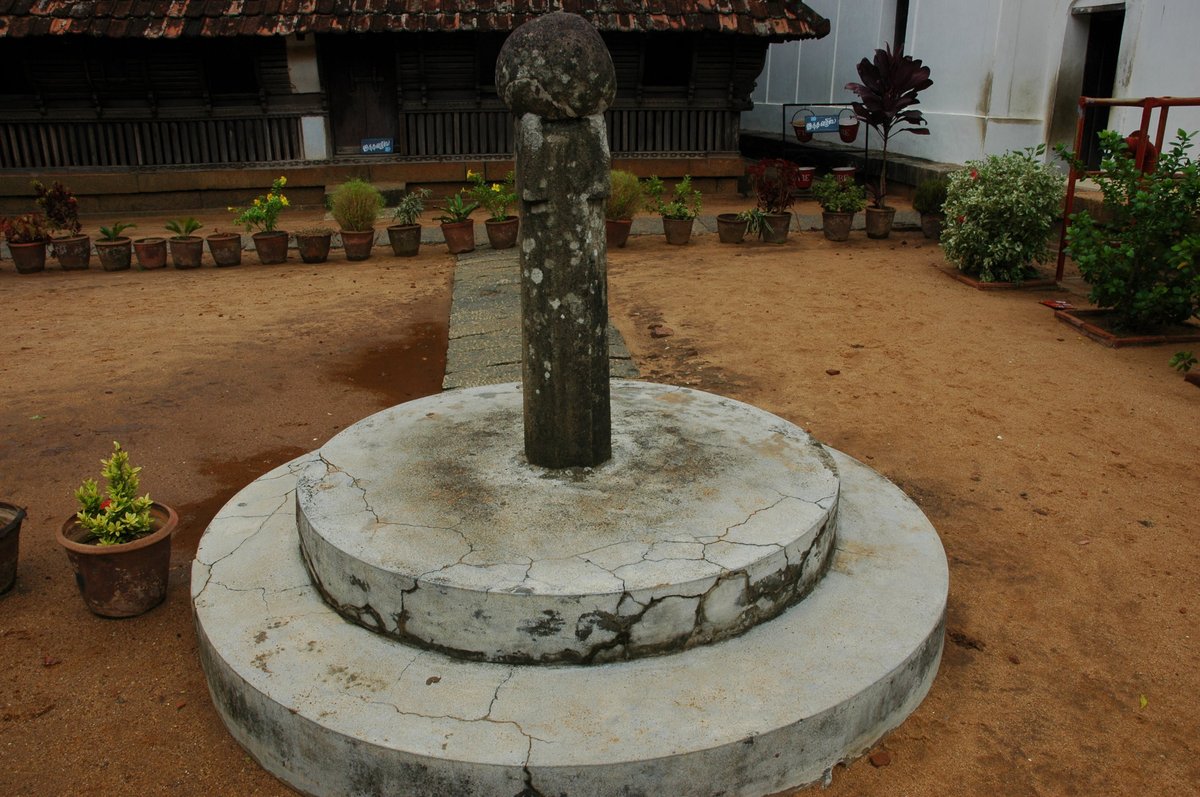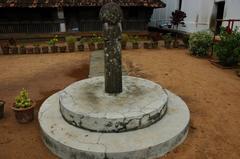
Visiting Padmanabhapuram Palace: Hours, Tickets, and Travel Tips
Date: 17/07/2024
Introduction
Padmanabhapuram Palace, located in Nagercoil, India, is an architectural and historical marvel that offers a deep dive into the rich heritage of Kerala. Constructed in 1601 AD by Iravi Varma Kulasekhara Perumal, the palace served as the administrative and residential headquarters of the Travancore rulers until the capital was moved to Thiruvananthapuram in 1795. Renowned for its traditional Kerala architecture, intricate woodwork, and expansive courtyards, Padmanabhapuram Palace stands as a testament to the cultural and political significance of the Travancore kingdom (Kerala Tourism). During the reign of Marthanda Varma, the palace saw significant expansions and renovations, transforming it into a grand structure that includes the Thai Kottaram (Mother’s Palace), Nataksala (Hall of Performance), and the Mantrasala (Council Chamber) (ASI). Today, the palace is a protected monument under the care of the Archaeological Survey of India (ASI) and continues to attract tourists from around the world, offering a unique glimpse into the history, art, and craftsmanship of Kerala (Cultural India).
Table of Contents
- Introduction
- Origins and Early History
- Architectural Evolution
- Cultural and Political Significance
- Decline and Preservation
- Architectural Features
- Art and Craftsmanship
- Historical Artifacts
- Restoration Efforts
- Visitor Information
- Travel Tips
- Nearby Attractions
- Accessibility
- FAQ
- Conclusion
Discover the Rich History and Architectural Marvels of Padmanabhapuram Palace
Origins and Early History
Padmanabhapuram Palace, located in Nagercoil, India, is a remarkable example of traditional Kerala architecture. The palace was originally constructed in 1601 AD by Iravi Varma Kulasekhara Perumal, the ruler of the erstwhile Travancore kingdom. The palace served as the administrative and residential headquarters of the Travancore rulers until the capital was shifted to Thiruvananthapuram in 1795 (Kerala Tourism).
Architectural Evolution
The palace complex underwent significant expansions and renovations during the reign of Marthanda Varma (1729-1758), who is often credited with transforming it into the grand structure it is today. Marthanda Varma, known for his military prowess and administrative acumen, fortified the palace and added several new structures, including the Thai Kottaram (Mother’s Palace), Nataksala (Hall of Performance), and the Council Chamber (ASI).
Cultural and Political Significance
Padmanabhapuram Palace was not just a royal residence but also a center of cultural and political activities. The palace played a crucial role in the administration of the Travancore kingdom. The Council Chamber, known as Mantrasala, was where the king held court and discussed state affairs with his ministers. The palace also hosted various cultural events, including traditional dance and music performances, which were integral to the social fabric of the time (Cultural India).
Decline and Preservation
After the capital was moved to Thiruvananthapuram, Padmanabhapuram Palace gradually lost its political significance. However, it remained a symbol of the rich cultural heritage of Kerala. In the 20th century, the Archaeological Survey of India (ASI) took over the maintenance of the palace, ensuring its preservation and restoration. The palace is now a protected monument and a popular tourist destination, attracting visitors from around the world (ASI).
Architectural Features
Thai Kottaram (Mother’s Palace)
One of the oldest structures in the complex, the Thai Kottaram, dates back to 1550 AD. This section of the palace is renowned for its intricate wooden carvings and traditional Kerala-style architecture. The building features a unique sloping roof and an inner courtyard, which are characteristic of the region’s architectural style (Kerala Tourism).
Nataksala (Hall of Performance)
The Nataksala, or Hall of Performance, is another significant addition made during Marthanda Varma’s reign. This hall was used for various cultural performances, including Kathakali, a classical Indian dance-drama. The hall is adorned with beautiful murals and wooden carvings, showcasing the artistic excellence of the period (Cultural India).
Mantrasala (Council Chamber)
The Mantrasala is perhaps the most important room in the palace, where the king held his council meetings. The chamber is designed to keep the room cool even during the hot summer months, thanks to its unique architectural features. The wooden ceiling is intricately carved, and the room is adorned with traditional lamps and furniture (ASI).
Art and Craftsmanship
The palace is a treasure trove of traditional Kerala art and craftsmanship. The wooden carvings, murals, and paintings found throughout the palace complex are exemplary of the region’s artistic heritage. The murals, in particular, depict various scenes from Hindu mythology and are painted using natural dyes, which have stood the test of time (Kerala Tourism).
Historical Artifacts
Padmanabhapuram Palace houses several historical artifacts, including ancient weapons, brass lamps, and traditional furniture. These artifacts provide a glimpse into the lifestyle and culture of the Travancore royalty. The palace also has a collection of ancient manuscripts and records, which are invaluable for historical research (Cultural India).
Restoration Efforts
The Archaeological Survey of India has undertaken several restoration projects to preserve the palace’s architectural and cultural heritage. These efforts include structural repairs, conservation of murals, and restoration of wooden carvings. The ASI has also implemented measures to protect the palace from environmental damage, ensuring its longevity for future generations (ASI).
Visitor Information
Visiting Hours: Padmanabhapuram Palace is open to visitors from 9:00 AM to 5:00 PM, with the last entry at 4:30 PM. It is closed on Mondays and national holidays.
Tickets: The entry fee is modest, with discounts available for children, students, and senior citizens. Guided tours are also available for a nominal fee.
Travel Tips
- Best Time to Visit: The best time to visit Padmanabhapuram Palace is during the cooler months from November to February.
- How to Get There: The palace is well-connected by road and is approximately 20 km from Nagercoil and 50 km from Thiruvananthapuram. Public transportation and taxis are readily available.
- Cultural Etiquette: Visitors are advised to dress modestly and respect the cultural heritage of the site.
Nearby Attractions
- Thirparappu Waterfalls: A scenic waterfall located about 35 km from the palace.
- Udayagiri Fort: A historic fort located 14 km away, offering a glimpse into the region’s past.
- Suchindram Temple: A famous temple situated 15 km from the palace, known for its architectural beauty.
Accessibility
The palace complex is partially accessible to visitors with disabilities. Wheelchairs are available at the entrance, and staff are on hand to assist where necessary. However, some areas may be challenging to navigate due to the historical architecture.
FAQ
Q: What are the visiting hours for Padmanabhapuram Palace?
A: The palace is open from 9:00 AM to 5:00 PM, with the last entry at 4:30 PM. It is closed on Mondays and national holidays.
Q: Are guided tours available at Padmanabhapuram Palace?
A: Yes, guided tours are available for a nominal fee, offering detailed insights into the palace’s history and architecture.
Q: How can I get to Padmanabhapuram Palace?
A: The palace is approximately 20 km from Nagercoil and 50 km from Thiruvananthapuram, with public transportation and taxis readily available.
Conclusion
Padmanabhapuram Palace stands as a testament to the architectural brilliance and cultural richness of Kerala. Its history, spanning several centuries, reflects the political and cultural evolution of the region. The palace’s preservation and restoration efforts ensure that this historical monument continues to inspire and educate future generations. Whether you’re a history buff or a casual traveler, Padmanabhapuram Palace offers a unique and enriching experience.
Call to Action
Plan your visit to Padmanabhapuram Palace today and immerse yourself in the rich history and culture of Kerala. Don’t forget to check out other historical sites and travel guides for Nagercoil and follow us on social media for more updates.
References
- Kerala Tourism. Discover the Rich History and Architectural Marvels of Padmanabhapuram Palace. Retrieved from https://www.keralatourism.org
- Archaeological Survey of India. Discover the Rich History and Architectural Marvels of Padmanabhapuram Palace. Retrieved from https://asi.nic.in
- Cultural India. Discover the Rich History and Architectural Marvels of Padmanabhapuram Palace. Retrieved from https://www.culturalindia.net

